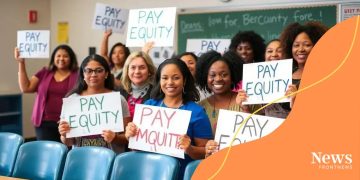Disability payment gap: understanding the disparities

The disability payment gap signifies the substantial difference in financial support received by individuals with disabilities compared to those without, affecting their quality of life and access to opportunities.
Disability payment gap is more than just a statistic—it’s a reality for countless individuals facing financial challenges. Have you ever wondered how these disparities shape lives and what can be done to foster equity? Let’s dive into this important topic.
What is the disability payment gap?
The disability payment gap refers to the significant differences in financial support that individuals with disabilities receive compared to those without. This gap can impact a person’s quality of life, access to resources, and overall well-being. But what exactly does this mean? Let’s explore.
Understanding the Gap
Many individuals with disabilities face challenges in securing adequate financial assistance. These can arise from various factors, including employment barriers and societal perceptions. As a result, the financial support they receive is often not enough to cover their basic needs. This can create a cycle of poverty that is difficult to escape.
Key Factors Contributing to the Gap
- Employment Opportunities: Limited job options lead to reduced income.
- Wage Discrepancies: Individuals with disabilities may earn less than their non-disabled peers.
- Access to Benefits: Not all individuals qualify for the same level of assistance.
- Social Stigmas: Negative perceptions can affect opportunities and support.
Moreover, the impact of the disability payment gap can be felt not only on a personal level but also within the community. Insufficient financial support can lead to increased reliance on public assistance programs, straining resources and affecting social services. Addressing this issue requires a comprehensive understanding of the underlying causes and a commitment to implementing effective solutions.
Various organizations strive to bring awareness to the disability payment gap. They advocate for policy changes to ensure fairness and equity in financial support for individuals with disabilities. These efforts aim to create a more inclusive society where everyone can thrive irrespective of their challenges.
Statistics showcasing the impact
Statistics play a crucial role in understanding the disability payment gap and its impact on individuals. These numbers reveal the stark realities many face daily. Let’s take a closer look at some key statistics that highlight this gap.
Employment and Income
According to recent research, individuals with disabilities are significantly less likely to be employed compared to their non-disabled peers. For instance, the employment rate among people with disabilities hovers around 19.1%, while the rate for those without disabilities is approximately 66.3%. This discrepancy directly affects their income levels.
- Income Disparities: The average income for people with disabilities is about 37% less than that of their non-disabled counterparts.
- Healthcare Costs: People with disabilities often incur higher medical expenses, which further exacerbate their financial situation.
- Living Costs: Daily living costs can be higher due to the need for assistive devices or accommodations.
These figures underline the vital need for change. The disability payment gap not only affects individual income but also influences broader economic participation. Higher disability rates can lead to increased reliance on social assistance programs, which strains public resources.
Social Implications
Alongside economic statistics, social implications are stark. Studies show that nearly 25% of adults with disabilities report feeling isolated due to their financial challenges. This sense of isolation can lead to mental health issues, further affecting their quality of life.
Furthermore, the lack of financial support can prevent these individuals from accessing education or training opportunities, perpetuating a cycle of poverty. Addressing these statistics is crucial for advocating for policies that can bridge the disability payment gap and promote equality.
Challenges faced by disabled individuals

Disabled individuals face numerous challenges that significantly impact their daily lives. These hurdles range from societal acceptance to financial stability, making it essential to understand their experiences. The disability payment gap is just one aspect of a broader array of issues.
Employment Barriers
Finding and keeping a job is often difficult for those with disabilities. Many employers may not recognize the potential of disabled individuals or assume they are less capable. This can lead to discrimination during the hiring process, which ultimately limits job opportunities.
- Job Availability: Many job sectors are not accommodating, limiting options for disabled individuals.
- Workplace Accessibility: Inadequate facilities can further hinder their ability to perform effectively.
- Stigma: Negative perceptions can lead to an unwelcoming environment.
Additionally, even when employed, disabled individuals may earn less money compared to their peers. Wages are often lower, which ties back to the disability payment gap and can leave them struggling to meet basic needs.
Social Isolation
Another challenge faced by many disabled individuals is social isolation. Financial limitations can restrict access to social activities and services. Many disabled people may struggle to connect with others, leading to feelings of loneliness.
Transport issues also play a significant role. Accessibility to public transportation can be limited, making it hard for disabled individuals to engage in community activities, which exacerbates their isolation. The inability to participate in social events can negatively affect mental health, leading to depression and anxiety.
Through these challenges, it is crucial to advocate for change and better support systems for those who face the disability payment gap. By addressing these issues, society can work towards creating a more inclusive environment that empowers individuals with disabilities.
Policy changes needed for improvement
To address the disability payment gap, significant policy changes are necessary. These changes can create a more equitable system for individuals with disabilities. Let’s explore some of the key areas where improvements can be made.
Increased Financial Support
One of the most pressing needs is to enhance financial support for individuals with disabilities. Often, the current assistance programs do not meet the basic living requirements. Policy-makers should consider raising the benefits provided to disabled individuals to a level that enables them to cover essential costs.
- Adjusting Benefit Amounts: Regularly review and increase benefit amounts based on the cost of living.
- Expanding Eligibility: Evaluate and revise eligibility criteria so more individuals can access the necessary support.
- Streamlining Processes: Simplify application processes to reduce barriers to obtaining assistance.
Moreover, improving accessibility to employment is crucial. Policies that promote inclusive hiring practices can encourage employers to provide job opportunities to those with disabilities. This could significantly help in closing the disability payment gap.
Accessibility Improvements
Physical accessibility in public spaces and workplaces is also an area needing reform. Policies enforcing accessibility standards can make a notable difference. This includes ensuring proper ramps, elevators, and adapted facilities are in place.
Furthermore, enhancing transport services can improve social inclusion. Ensuring that public transportation meets accessibility standards allows more disabled individuals to engage with their communities freely. These changes can reduce feelings of isolation and promote a more inclusive society.
Finally, it’s essential to advocate for continuous dialogue between disabled individuals and policy-makers. Listening to the needs of the community can guide effective legislation. Such efforts can lead to meaningful changes that bridge the disability payment gap and promote greater equity for all.
Real stories of those affected
Real stories highlight the true impact of the disability payment gap on individuals and families. These narratives provide insight into the challenges faced by disabled people and emphasize the need for change. Hearing directly from those affected can inspire collective action.
Personal Experiences
One individual named Sarah, who has a mobility impairment, shares her journey. Despite her qualifications, she struggled to find a job. Many employers dismissed her potential due to her disability. This led to financial struggles, forcing her to rely on disability payments, which barely covered her living expenses.
- Struggles with Employment: Sarah’s experience is not unique; many disabled individuals face similar barriers when seeking work.
- Financial Limitations: The limited support provided often means tough choices between essentials like food or medical care.
- Mental Health Effects: The stress of financial instability can lead to anxiety and depression.
Another story comes from Ben, a father of two who was diagnosed with a chronic illness. His treatment was costly, and the insurance coverage was inadequate. After exhausting his savings, he had to rely on government assistance. Ben described the struggle to maintain his family’s dignity while dealing with financial insecurity.
The Call for Change
These stories shed light on the urgent need for reforms that address the disability payment gap. Many individuals are not just in need of financial support but also seek opportunities for meaningful employment. For these individuals, a stable income is essential not only for survival but also for pride and autonomy.
Through these narratives, we can better understand the systemic issues that contribute to the challenges faced by disabled individuals. The stories underline the importance of advocacy and policy changes to ensure that everyone, regardless of ability, has access to equitable resources and opportunities.
In conclusion, addressing the disability payment gap is essential for creating a more equitable society. By understanding the challenges faced by individuals with disabilities and listening to their real stories, we can advocate for meaningful policy changes. It is crucial to increase financial support, improve accessibility, and promote inclusive employment opportunities. Together, we can build a community where everyone, regardless of ability, has a fair chance to thrive.
FAQ – Questions about the disability payment gap
What is the disability payment gap?
The disability payment gap refers to the significant differences in financial support that individuals with disabilities receive compared to those without.
What challenges do disabled individuals face?
Disabled individuals often face challenges like employment barriers, social isolation, and insufficient financial support, which exacerbate their struggles.
How can policy changes improve the situation?
Policy changes can increase financial support, enhance workplace accessibility, and promote inclusive hiring practices to better support disabled individuals.
Why are real stories important in this context?
Real stories highlight personal experiences, emphasizing the urgency for change and allowing us to understand the real-life impacts of the disability payment gap.





